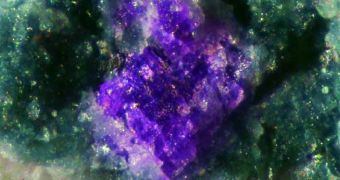Writing in a recent issue of the journal Mineralogical Magazine, Dr. Peter Elliott with the University of Adelaide details the discovery of a new mineral in a remote location in Western Australia. The mineral, pictured above, has been named putnisite.
In his paper in the journal Mineralogical Magazine, Dr. Peter Elliott explains that, according to evidence at hand, this mineral is unlike any of the other nearly 4,000 mineral species that have until now been documented by science.
Thus, putnisite appears as dark pink, nearly purple spots on dark green and white rock, and it is translucent. Its makeup includes strontium, calcium, sulphur, chromium, hydrogen, oxygen and carbon. By the looks of it, this is a fairly unusual combination as far as ingredients for minerals go.
“Most minerals belong to a family or small group of related minerals, or if they aren't related to other minerals they often are to a synthetic compound – but putnisite is completely unique and unrelated to anything,” the mineralogy researchers said in a statement.
“Nature seems to be far cleverer at dreaming up new chemicals than any researcher in a laboratory,” the University of Adelaide scientist added, as cited by Phys Org.
Experiments carried out by Dr. Peter Elliott and his colleagues have shown that this new mineral has a Mohs hardness of 1.5 to 2 on a scale that goes up to 10. This means that it is fairly soft. In fact, the mineralogy researcher claims that its softness is similar to gypsum and brittle.
For the time being, scientists are unable to say whether or not this newly discovered mineral might have any commercial applications. However, it is to be expected that further investigations will follow, and that researchers will soon have an answer to this question.
Information shared with the public says that putnisite was discovered in a surface outcrop at Lake Cowan, north of Norseman in Western Australia. By the looks of it, it was found during prospecting for a mining project.
The mineral was first handed over to CSIRO (the Commonwealth Scientific and Industrial Research Organization), i.e. Australia's national science agency. After folks at CSIRO had a look at it, putnisite was passed on to Dr. Peter Elliott, who took care of carefully analyzing its makeup and its properties.
“What defines a mineral is its chemistry and crystallography. By x-raying a single crystal of mineral you are able to determine its crystal structure and this, in conjunction with chemical analysis, tells you everything you need to know about the mineral,” the scientist detailed his work.
This new mineral was named after Australian mineralogists Andrew and Christine Putnis, and its moniker must now be approved by the International Mineralogical Association.

 14 DAY TRIAL //
14 DAY TRIAL //